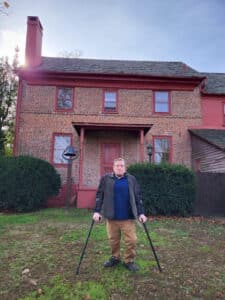Winter 2016: The Port Authority has released the plans and announcement for the new entrances to the paths.
Approximately 345,000 bike riders and 205,000 pedestrians make their way across the George Washington Bridge annually, based on data obtained from the bike & pedestrian counter on the south path of the bridge.
In December 2011, the Port Authority announced that they would be replacing all 592 of the suspender ropes on the George Washington Bridge, and that this 10-year “Restoring the George” project would require the south path be closed for the 5 years needed on that side. The late Ted Semegran of the Bicycle Touring Club of North Jersey was the first to call out that this meant the bridge would be effectively closed to all but the hardiest riders (including those who have no choice but to commute by bike), as the north path has 171 steps across numerous staircases on both ends of the north path. Riders currently must carry their bikes up and down these staircases to cross when the south path is closed, and that would be the state for the entire 5-year period.

A coalition of organizations on both side of the bridge, including NJ Bike & Walk Coalition, Transportation Alternatives, New York Cycle Club and 5 Boro Bicycle Club, testified in February 2013 at the Board of Commissioners meeting of the Port Authority, asking that this situation be addressed. Shortly thereafter, NJBWC, TA and BTCNJ participated in a day-long session consisting of a walk-through of both paths with the GWB bridge engineering and management teams, and a brainstorming session where we identified the most critical issues: the staircases and the steep narrow approach ramp on the NY-south side. Participants discussed in detail the pros and cons of the design of both paths from a cyclist’s perspective and highlighted the trouble spots as well as suggested improvements.
Under the Port Authority’s original plan, access to the north and south paths of the bridge would alternate during the maintenance project. Unfortunately, neither path is ideal. The south path closure is expected to last three to four years; additionally, its New York City ramp is a dangerous route with a tight hairpin turn at the end. The north path has its own challenges including 171 stairs to negotiate with a bike on your shoulder. Both paths suffer from low visibility at the towers, crowded ramps leading to the bridge, and tight squeezes where the paths narrow at gateways and standpipes. For these reasons, our coalition pursued a solution for both paths.
With the suspender rope “Restoring the George” project already having its scope defined, we were limited in what we could get. But we were encouraged by the Authority’s words: “We hear you; we want to fix the problem.”
Over the ensuing several years, NJBWC and TA negotiated a $118 M win that includes the rebuild of all four entrances to the paths (NJ north and south; NY north and south), separated paths for bike riders and pedestrians, new sidewalks, ADA compliant access ramps, elimination of stairways and constricted turns on access ramps, introduction of spacious entry plazas and viewing platforms, and safety fencing along ramps and main span sidewalks to eliminate suicides (something the PA deals with on a regular basis). For more information and renderings of the exciting changes to come, click here, and for more on our take of the project, click here.

Continuing our advocacy, in 2014 we convinced the Port Authority to install a state of the art bicycle and pedestrian counter on the south path, so that for the first time,actual counts of riders and walkers could be captured and collected on an on-going basis. Any counts prior to this installation are one-off captures, if they exist at all. Figures for 2015 were released in early 2016 by the Port Authority.
In early February 2017, NJBWC and TA led a sign-on campaign of bicycle clubs and advocacy organizations on both sides of the river in providing comments to the Port Authority’s 10-year Capital Plan. Among other requests, we asked for an exploration into the possibility of constructing wider paths around the towers, as these tend to be areas of safety concern to many riders. On February 16, we listened in to the PA Board of Commissioners’ public proceedings on the Capital Plan, and were thrilled to learn that our request had been answered; that the paths around the towers will be modified so that the sharp angles will be transformed into smooth entrances into the tower area. Another win for safety for bike riders and pedestrians on the George Washington Bridge!
We thank the Port Authority for hearing our concerns back in February 2013 and for working with us throughout the process to find a way keep the bridge paths open to riders for the entire construction period and in doing so, for providing permanent changes to the bridge paths, for focusing on bike rider and pedestrian safety, and ultimately, for making the George Washington Bridge a much more enjoyable place to ride and visit.














































































